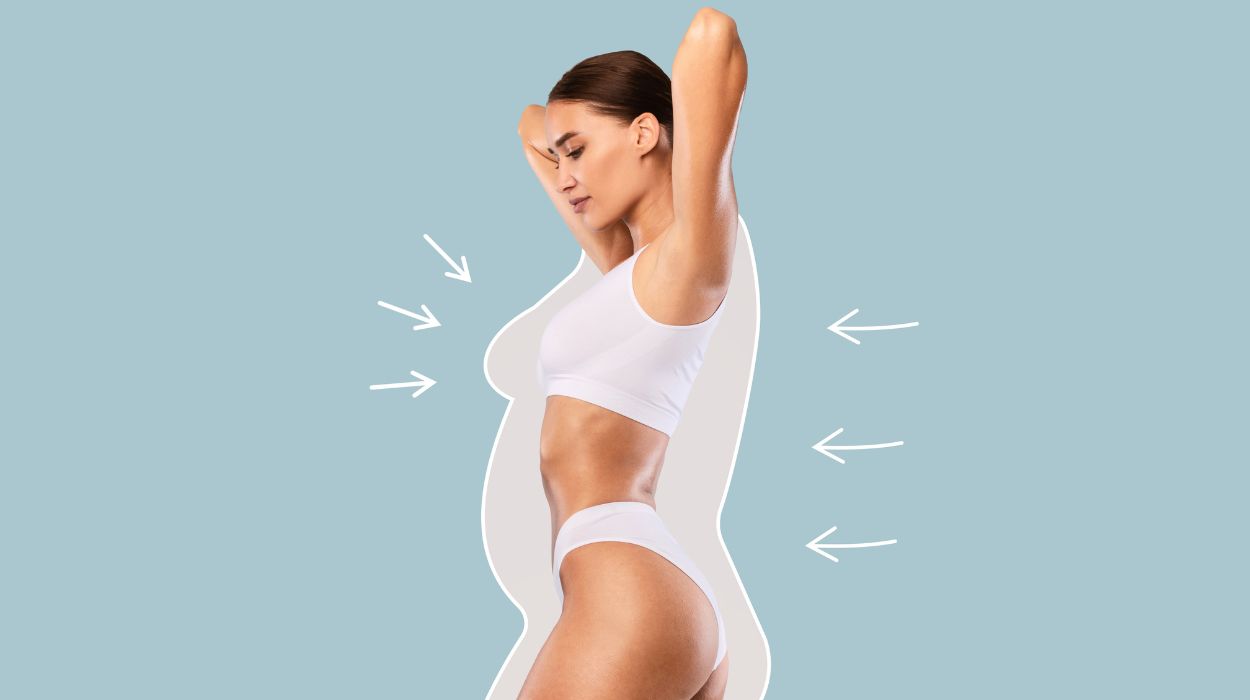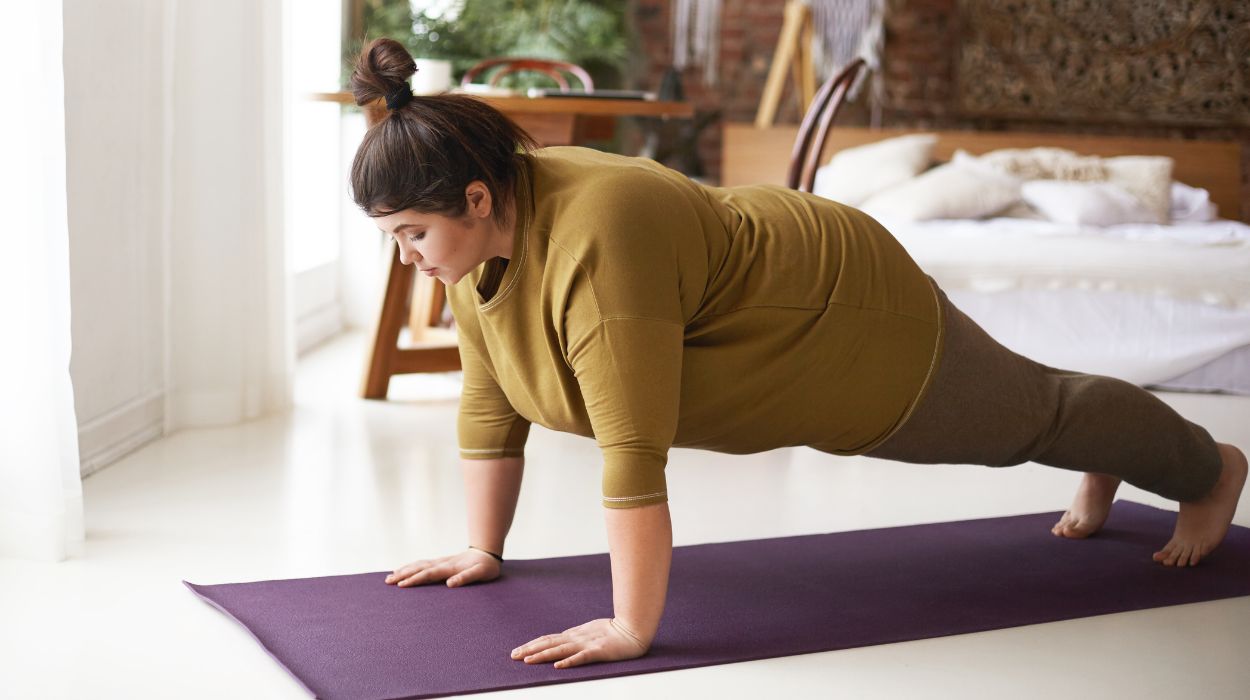When you are on a weight loss plan, you may ask yourself, “How does fat leave the body?” There isn’t a simple answer because it turns out that fat loss is a complex physiological process.
If you’re trying to achieve a lower body fat percentage, it’s helpful to understand how fat loss works. Below, learn what happens when your body is burning fat for weight loss. You’ll also learn about different types of fat and better understand body composition.
How Does Fat Leave Your Body?
People who are trying to lose weight may wonder, “How does fat leave your body?” In short, fat loss occurs when stored fat is burned for energy.
Fat is released[1] from the fat cell in the form of triacylglycerol. It then travels to the muscles, which use it for energy. After this process, fat leaves the body in the form of carbon dioxide via the lungs[1] during exhalation.
Fat can also be excreted[1] via urine, feces, tears, and sweat.
How Does Fat Leave The Body When You Lose Weight?

So, where does the fat go when you lose weight? The answer lies in the physiology of fat loss. The process begins[1] with the release of fat from a fat cell via physiological processes.
When fat loss occurs, the fat cells release[1] dietary fat into the bloodstream as free fatty acids. The blood then carries these fats to whatever body tissue requires energy.
Ultimately, these fats travel[1] to muscles, where they are utilized for energy. The fatty acids make their way inside the mitochondria, the cell’s energy center, where they are burned. A person appears leaner after this process because fat cells shrink.
Some people mistakenly believe that we lose fat cells with fat loss. However, what happens is that fat cells empty[1] themselves. Body fat is a reserve energy source, and it can be burned for energy when needed.
You might still ask, “How do fat cells leave the body?” Ultimately, fat leaves the body as a byproduct of the above processes.
We exhale burned fat in the form of carbon dioxide, so the lungs[2] play a major role in fat loss. Fat can also leave the body[2] via urine, feces, sweat, and tears.
Understanding Body Fat
Body fat is a reserve energy source. Researchers have described fat cells as storage tanks[1] that can be emptied out when the body needs energy. While having too little fat can be problematic, having too much fat can cause[1] health problems like type 2 diabetes.
Excess fat is linked to obesity and various health problems. However, it’s important to understand that different types of body fat exist.
Types Of Body Fat
There isn’t just one type of body fat. When learning about fat loss, it’s helpful to understand that there are two primary types of fat. These are white fat adipose tissue and brown adipose tissue.
Not all body fat is unhealthy. White fat can come[3] with health risks, but brown fat cells can improve[4] metabolic health.
White Adipose Tissue
White adipose tissue is the type that stores[5] excess calories in the form of triglycerides. The white adipose tissue stores extra calories as energy when a person eats extra calories. These triglycerides can be broken down to supply energy to the body.
Having these energy reserves was important historically[5] during times of famine. However, in today’s world, plenty of food is typically available. So, people consume excess amounts of calories with no need to utilize these reserves, leading to obesity.
Unfortunately, white adipose tissue will continue to grow[5] if a person consumes too many calories. This can lead to obesity and related health conditions.
White fat can be broken down into visceral fat and subcutaneous fat. Visceral fat surrounds[3] the body’s organs, whereas subcutaneous fat is beneath[3] the skin.
Both visceral and subcutaneous fat come with health risks.[3] However, visceral fat comes with greater[6] risks to metabolic health.
Brown Adipose Tissue
Brown fat differs from white fat as it plays a role in something called adaptive thermogenesis.[5] This process creates heat, especially when the body is exposed to cold temperatures.
Brown fat cells receive their color[1] from the large numbers of blood vessels and mitochondria found in these cells. Energy is released from brown fat cells in the form of heat.
Scientists used to believe that only newborns had brown fat, but studies[4] have shown that adults also carry brown fat. This fat type t has been studied for its potential role in weight loss. Brown fat could increase[4] fat burn by speeding up resting metabolism and promoting cold-induced fat-burning processes.
Brown fat cells offer several health benefits. For example, people with more brown fat have less[7] visceral fat, which reduces abdominal obesity. This further lowers[7] blood sugar and cholesterol levels and reduces[7] diabetes risk.
Benefits Of A Healthy Level Of Body Fat
Excess accumulation of body fat, particularly in white adipose tissue, is linked to[8] obesity-related diseases. For instance, having excess body fat is linked[3] to metabolic syndrome, insulin resistance, high blood pressure, and inflammation. Visceral fat, in particular, can increase[3] the risk of diabetes.
Given the risks of obesity, weight loss that leads to a lower body fat percentage can improve health. Reducing your body fat to a healthy level lowers the risk of obesity-related diseases.
If you’re overweight, losing weight is associated with many health benefits:[9]
- Reduced risk of diabetes.
- Lowered blood pressure.
- Improved cholesterol levels.
- Remission of obstructive sleep apnea symptoms.
- Improvement in symptoms of polycystic ovarian syndrome, including increased fertility.
- Reduced risk of cardiovascular disease.
Tips To Speed Up Fat Loss

If you’re on a fat loss journey, you may be interested in learning how to lose weight fast. While this is probably common, the truth is that rapid weight loss isn’t the best choice.
Research[10] has shown that people lose more fat with gradual compared to rapid weight loss. Gradual weight loss is also better for the metabolism, as it causes less[10] of a decline in resting metabolic rate and less lean muscle loss
If you’re looking for info on speeding up fat loss, learning strategies for sustainable weight loss is helpful.
Eating In A Calorie Deficit
To lose weight, you must be in a calorie deficit. This means you’re burning more calories than you consume each day. Calorie needs calculators aren’t entirely accurate, but they can give you an idea of how many calories you burn daily.
Once you determine your daily calorie burn, subtract calories to create a deficit. It is recommended to stick to a deficit of 500 to 750 calories[11] daily to lose weight 1-1.5 lbs per week. So, if you burn 2,000 calories daily, you should consume 1,250 to 1,500 for weight loss.
Once you have created a calorie deficit, making dietary changes is important. Weight loss diets should include[12] plenty of fruits and vegetables, whole grains, and lean protein sources. You should also limit[12] added sugars and processed foods.
Increasing Protein Intake
When trying to lose weight, increasing your protein intake is often helpful. This is because protein increases diet-induced thermogenesis.[13] This means you’ll increase the amount of calories you burn, absorbing and storing nutrients.
Protein also supports the growth and maintenance of lean muscle mass, increasing metabolism.[13] This is beneficial for losing weight, as well as for maintaining weight loss. With a higher resting metabolism, you’re less likely to regain weight.
Furthermore, protein increases feelings of satiety,[13] which means you will feel more full and satisfied after eating. If you feel full, you’ll easily stick to a calorie deficit for weight loss.
Getting Plenty Of Exercise
Burning calories is essential for fat loss. After all, the more calories you burn, the easier it is to be in a calorie deficit.
Physical activity is beneficial for losing weight and preventing weight regain. One study[14] found that people who lost weight and kept it off burned 812 calories daily from exercise.
The bottom line is that adding exercise to your routine will accelerate fat loss because you’ll burn more calories. Think back to the answer to, “How does fat leave your body?” When you need it for energy, it is released from fat cells and then burned.
When you exercise, your calorie burn increases. If you’re eating in a calorie deficit, your body will call upon body fat stores for energy during exercise, supporting total body fat loss.
The Best Type Of Exercise For Fat Loss
Regarding the best exercise for fat loss, it depends on your preferences. Moderate-intensity exercise produces[15] a similar amount of fat loss compared to high-intensity and sprint exercises. However, high-intensity and sprint training exercises are more efficient[15] for fat loss.
You can achieve fat loss benefits with shorter[15] sprint training and high-intensity sessions. On the other hand, if you choose moderate-intensity exercise, you’ll need to work out longer[15] for the same benefit.
Research has shown that high-intensity interval training reduces body fat with a 40%[16] lower time commitment than moderate-intensity exercise. People losing weight with moderate-intensity exercise must work out for about 158 minutes[16] a week. Those choosing high-intensity interval training can lose fat with just 95 minutes[16] of weekly exercise.
If you have more time, aerobic exercise like walking or jogging steadily will work fine. However, you can also lose fat with high-intensity interval training that is more time efficient. This would involve alternating low-intensity recovery periods with high-intensity bursts, such as sprinting.
It can also be helpful to include weight training in your routine. One recent study found that lifting weights for nine months increased resting metabolic rate by about 5%[17] on average.
Other Strategies To Consider
In addition to diet and exercise interventions, fat-burning supplements may be helpful for fat loss. These supplements will not magically cause weight loss alone, but they can help when used alongside diet and exercise.
Research[18] has shown that the following fat burners can be effective for weight loss:
- Epigallocatechin from green tea.
- Caffeine and chlorogenic acid from coffee.
- Capsaicinoids from chili peppers.
- Lipoic acid, an antioxidant.
- CLA, a type of fat used in combination with resveratrol.
Several products on the market can help the fat-burning process. Check product labels to determine what ingredients they contain. The fat burners above can complement a healthy lifestyle to promote weight loss, but it’s important to always consult your medical provider first.
Conclusion
The answer to “How does burned fat leave the body?” Isn’t exactly simple. First, stored fat has to be released[1] into the bloodstream and used as energy. Eventually, it leaves the body as exhaled carbon dioxide via the lungs or bodily fluids like urine or sweat.
Understanding this process can help you develop an appreciation for the work your body does to lose weight. If you’re interested in fat loss, remember that achieving a healthy body weight reduces your disease risk. So, putting forth the effort to lose weight is worthwhile.
Frequently Asked Questions
You will notice fat loss if you are losing weight and your body fat percentage is dropping via data from a machine or device.
You cannot choose where your body loses fat first. Factors like genetics[19] will determine where your body stores and loses fat first.
It depends on how quickly you’re losing weight. If you drop weight quickly, you will notice fat burn sooner. However, slow, steady weight loss is more sustainable.
Fat cells are not permanently destroyed when you burn fat. Instead, they are emptied[1] out, shrinking in size as fat leaves the body.
 Evidence Based
Evidence Based
